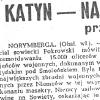| Source | Dziennik Ba³tycki, Gdañsk – Gdynia, Sunday, 17th February 1946 |
| Event referred to | Nuremberg War crimes trial |
| Technological characteristics | text
A4 page
pdf
|
| Description of the source | Front page of Dziennik Ba³tycki
Newspaper archive
Polish
printable
|
| Contextualisation of the source | Blaming the Germans for the murders in Katyñ |
| Interpretation of the source | 15.ooo Polish soldiers were murdered in a wood near Smolensk, Katyn. The Soviets tried to confirm the whole world that it was the Germans who were responsible for it and wanted to point out which methods they were using to reach their aim. The Germans were told to have been terrorising the so called witnesses of the murder in order to blame the Soviets for the crime.
The public prosecutor told that the bodies were buried in big mass graves and afterwards bushes were planted on them to hide any reminiscences. Besides the crime in Katyn the Germans were accused of murdering 50.000 Soviet captives and driving Jugoslavians to a special death camp in Norway, where the prisoners usually died from cold. The Soviet prosecutor, Pokrowski also mentioned the cruelty with which Czech captives were treated: before the execution their ears were cut off and their skin was fleeced of.
The source isn’t very reliable, because from 1989 when the Soviet might fell, it is known that it was Stalin that ordered the Polish soldiers murdered. It shows that the Soviets wanted to blame the Germans with their own quilt and that it is often the winners, who write history.
|
| Original Contents | |
| Original Contents (English Translation) | Earlier today The Russian prosecutor Pokrovskiy has been talking about murdering of 15,000 officers, Polish POWs, a war crime perpetrated in the Katyn woods, near Smolensk. It was one of the biggest German crimes during the war. Having committed the massacre, Germans attempted to shift the responsibility on Soviets, blaming them before the rest of the world.
Prosecutor Pokrovskiy then commenced to characterize instruments and methods used by the German propaganda to mislead the public opinion of the civilized world. As well as attempting bribery, Germans used terror against the alleged witnesses selected from among civilians living in the Katyn area. They were forced to testify before international commissions brought onto the crime scene by Germans that the killings had been carried out by Soviet soldiers on their superiors’ orders. That all resulted in a firm conviction among the Polish public opinion, that this horrible crime committed in spring 1940 had been a work of Soviets.
Next, the soviet prosecutor described before the court the methods of murdering defenseless prisoners of war, the way of burying the corpses in layers and covering up the traces by planting trees over the mass graves of the murdered ones. A number of further findings in other places proves that the method which had been employed in executing Polish POWs, had also been used by the Nazi murderers to kill Soviet, Yugoslav and other prisoners of war. The prosecutor mentions a mass grave of 50,000 Soviet POWs as well as a special death camp for Yugoslav prisoners which had been organized in the far north of Norway where several dozen thousand of Yugoslavs froze to death.
Finally, the prosecutor quotes a Czechoslovak government report, which describes in detail Nazi ways of tormenting Czechoslovak prisoners who had their eyes gouged, their ears cut off, their tongues pulled out and who were skinned alive before they were killed.
|
